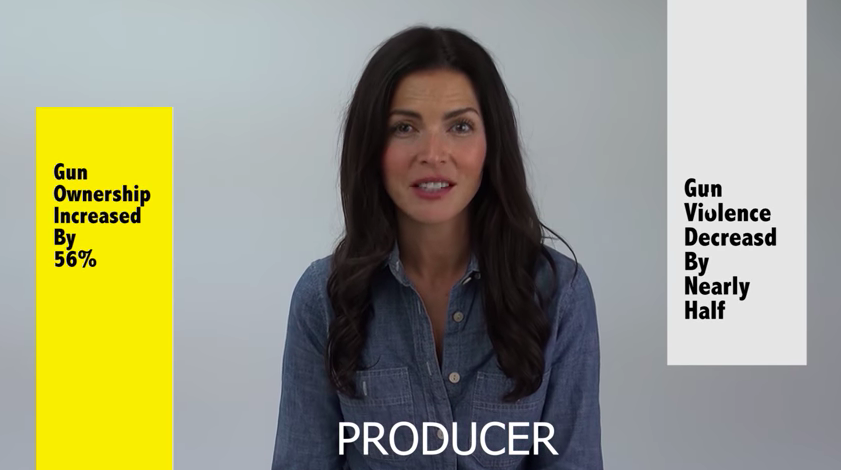In March 2018, two conservative activists and satirists, Austen Fletcher (also known as Fleccas) and MAGA Midge, collaborated on a viral video about gun violence in which actors appeared to respond in shock to a series of facts they were asked to read from a teleprompter.
In the video, MAGA Midge tells the actors, "We're going to have you reading from the teleprompter — these are real facts, these are all true, well-researched facts about gun control." The video has been watched millions of times across YouTube and social media, and we received several inquiries about the accuracy of the "facts" contained in it, which include some of the most commonly used pro-gun rights talking points.
This is the first installment of our two-part examination of the 12 factual claims contained in the viral March 2018 video. You can read the second part here, and you can watch the video itself below:
According to the CDC, there were roughly 38,000 gun deaths in 2016. Two thirds of them were suicides.
Mostly True.
According to figures recorded by the Centers for Disease Control (CDC), 37,848 deaths were attributed to the use of a firearm in 2016. Suicides made up 60.6 percent (not quite two-thirds) of those deaths, along with 14,415 homicides (38.1 percent), and 495 accidental gun-related deaths (1.3 percent).
There are over 300 million guns in the United States.
True.
No official tally of firearms in circulation at any given time is kept by any central location, but several recent estimates have ranged from 270 million to 357 million, so the video's statement seems a reasonable figure.
There are over five times more murders by knives than by rifles.
Unproven.
We have addressed this rather misleading claim in previous pages. In brief, Federal Bureau of Investigation statistics cited as the source of this statement are incomplete, and do not give a full picture of the ratio of homicides by knife to those caused by rifles (as a subcategory of firearms). However, FBI statistics show that firearms as a whole are involved in vastly more intentional killings than are knives.
The U.S. has the highest gun ownership rate in the world, but ranks 28th in gun murders.
Mixture.
The source for this claim is a 2012 ranking published by the UK newspaper the Guardian, which used data from the Small Arms Survey (a Swiss research project based at the Graduate Institute International and Development Studies in Geneva) and from the United Nations Office on Drugs and Crime (UNODC), which tracks homicide rates around the world, including homicides involving firearms.
In their 2007 annual report, the SAS found there were 89 civilian-owned firearms for every 100 people in the United States. This gave the United States by far the highest prevalence of guns out of 178 countries.
Sources on all sides of the wider gun control debate in the United States have frequently cited the SAS figures, but they are now years old and may no longer offer an accurate reflection of reality. A spokesperson for the project told us SAS would be publishing updated statistics later in 2018.
In 2009, the most recent year for which an extensive international comparison is possible using the UNODC data, the United States ranked 16th out of 54 countries, with 3.3 gun-related homicides for every 100,000 people in the country.
In 2011, some 59 percent of all homicides in the United States involved firearms, meaning the U.S. ranked 19th out of 62 nations by this metric.
The Guardian's ranking, which was used as a source for the claim in the video, is not misrepresented, but it ranks homicide rates using data from a variety of different years, which is not an ideal metric.
Although some discrepancies in the rankings may exist, the basic point made in the video is sound; despite the prevalence of guns in the United States being the highest in the world, the rate of gun-related homicides in the United States is far from the highest in the world.
Handguns are responsible for more than 80 percent of total mass shootings.
Mostly False.
This claim is a bit of a mess and appears to be quite a way off the truth.
The source of the claim is a 2014 New York Times op-ed column which is cited under the video. Referring to the early 1990s, Lois Beckett wrote that "Handguns were used in more than 80 percent of gun murders each year ..."
Note that this figure relates to all gun-related murders, not specifically mass shootings, as the video incorrectly stated. This is not a trivial distinction, considering the fact that much of the debate about gun control revolves around the role of semiautomatic rifles in mass shootings, such as the AR-15.
Beyond that, it's difficult to evaluate the accuracy of the claim made in the video, because it's so ambiguously stated. Does the 80 percent refer to the number of deaths from mass shootings, or the number of mass shooting incidents? How is a mass shooting defined for this claim? How does the claim factor in mass shootings in which the assailant used more than one type of weapon (a common occurrence)? And to what time period does the claim refer?
Because of the ambiguity of the video's claim, in order to get at least a sense of the role played by handguns in mass shootings we analyzed the incidents documented by Mother Jones in their mass shootings database for the two-year period between 10 March 2016 and 9 March 2018. We applied the FBI's definition of a "mass killing" — three or more people shot dead in public, not including the assailant — to this data. (You can find our analysis here.)
We found 18 mass shootings that met the FBI's criteria. In five cases (28 percent), the assailant used only a handgun to kill every victim. In eight cases (44 percent), the assailant did not use a handgun at all, and in five cases (28 percent) the assailant used both a handgun and other firearms (rifles and shotguns) to kill his victims. In total, a handgun was used in 10 out of 18 mass shootings. That's 56 percent, a much lower proportion than the 80 percent mentioned in the video. A firearm other than a handgun was used in 13 out of the 18 incidents (72 percent).
We also know that handguns were vastly less lethal in those mass shootings. The five incidents involving only a handgun led to 19 deaths out of 203 total mass shooting killings. The eight incidents not involving a handgun led to 97 fatalities.
In the four most lethal mass shootings since March 2016, the attacker either exclusively or predominantly used a rifle rather than a handgun. These four attacks — at the Pulse nightclub in Orlando, the Las Vegas massacre, the Sutherland Springs church massacre, and the Parkland school shooting — caused 150 out of the 203 deaths (74 percent) in all mass shootings in that two-year period.
This means deaths in mass shootings caused by handguns were vastly outnumbered by those caused by other types of firearm.
Between 1993 and 2003, gun ownership increased by 56 percent, while gun violence decreased by nearly half.
Mostly True.
Fletcher told us that the source of this claim was a 2015 post by the conservative American Enterprise Institute (AEI), which read as follows:
Adjusted for the US population, the number of guns per American increased from 0.93 per person in 1993 to 1.45 in 2013, which is a 56% increase in the number of guns per person that occurred during the same period when gun violence decreased by 49%.
Two things to note here are that Midge appears to have misspoken in the video: the period in question is 1993-2013, not 1993-2003 (although the trends are the same for both periods), and by "gun ownership" she means the prevalence of guns (i.e., number of guns per person) rather than the rate of gun ownership (the percentage of the population that owns guns).
In any event, the figures in the AEI post were in turn taken from two sources: a 2012 study published by the non-partisan Congressional Research Service (CRS), and a 2015 Washington Post article. As we've already noted, no official count of the number of privately-owned firearms in circulation is kept in the United States, and the figures used by the CRS, the Washington Post, and the AEI are all estimates, albeit methodologically reasonable ones.
The AEI article claims "the number of privately owned firearms in [the] U.S. increased from about 185 million in 1993 to 357 million in 2013." The figure of 185 million is not mentioned in either the CRS study or Washington Post article and appears to be an extrapolation. However, it's not an outrageous one: the CRS study posits an estimated 192 million guns were in circulation one year later, in 1994. In 1993, 185 million guns would equate to around 72 guns for every 100 people in the country (the population in July 1993 was 257.8 million).
The figure of 357 million guns in 2013 is an estimate provided by the Post, but it comes with a caveat, as the Post itself outlined: "This is just an estimate. These numbers are blind to firearms that enter and exit the country illegally, and to guns that break down, or are lost or destroyed."
Nonetheless, those estimates would equate to 113 guns for every 100 people in the United States (the population in July 2013 was 316 million). Between 1993 and 2013, then, the increase in the prevalence of firearms (from 72 to 113 guns per 100 people) would represent a 57 percent increase, which is actually slightly larger than the increase claimed by the AEI and by Midge.
Even if we used more conservative estimates, the trend is clear: both the number and prevalence of privately-owned firearms has increased significantly in the past 20-25 years.
Finding the change in the gun homicide rate over the same 20-year period is much more straightforward. According to CDC figures, in 1993 the number of gun-related homicides per 100,000 people was 7.0, but by 2013 it was 3.6. That's a 49 percent decline, as the American Enterprise Institute, and Midge, correctly state.
However, this doesn't prove a causal correlation. We can't say, based on these two trends alone, that the gun-related homicide rate decreased because of an increase in the prevalence of guns. Also, a striking contrast exists between the increasing prevalence of firearms, on the one hand, and the decreasing rate of firearm ownership on the other.
According to a survey by the polling company Gallup, the proportion of respondents saying they had a gun in their home or on their property decreased from 54 percent in 1993 to 39 percent in 2013. That's a fall of 28 percent. This downward trend in the rate of gun ownership is corroborated by data published by the University of Chicago's NORC ("non-partisan and objective research center"), which found a 21 percent drop in the percentage of households with guns between 1993 and 2012.
These contrasting figures suggest at first glance that the percentage of households with guns in them is falling, but individual gun owners are buying more guns.
To read Part II of this two-part fact check, click here.


